Analysis of Ethical Dilemmas in the Right to Child Case Study
VerifiedAdded on 2020/03/16
|10
|2455
|130
Case Study
AI Summary
This case study analyzes an ethical dilemma concerning the 'Right to Child,' focusing on a scenario involving a child named Sai Munn and educators. The core issue revolves around decision-making when faced with conflicting options, specifically regarding the child's behavior and the educators' response. The analysis explores the ethical implications of forcing the child to participate in activities and the resulting consequences. The document references the UNCRC, advocating for child protection, the right to play, and the importance of non-discrimination. It suggests solutions such as staff training, child counseling, and the removal of harmful objects. The study also examines the professional, legal, and rights-based considerations that influence the resolution, including the ECA code of ethics, NQS standards, and legal frameworks protecting children. Furthermore, it highlights the significance of ethical considerations such as beneficence, justice, and the importance of understanding psychological factors influencing a child's behavior. The reflection emphasizes the need for educators to foster diversity, listen to children, and advocate for their rights through continuous learning and the creation of a supportive environment. The case study draws upon a range of academic sources to support its arguments.
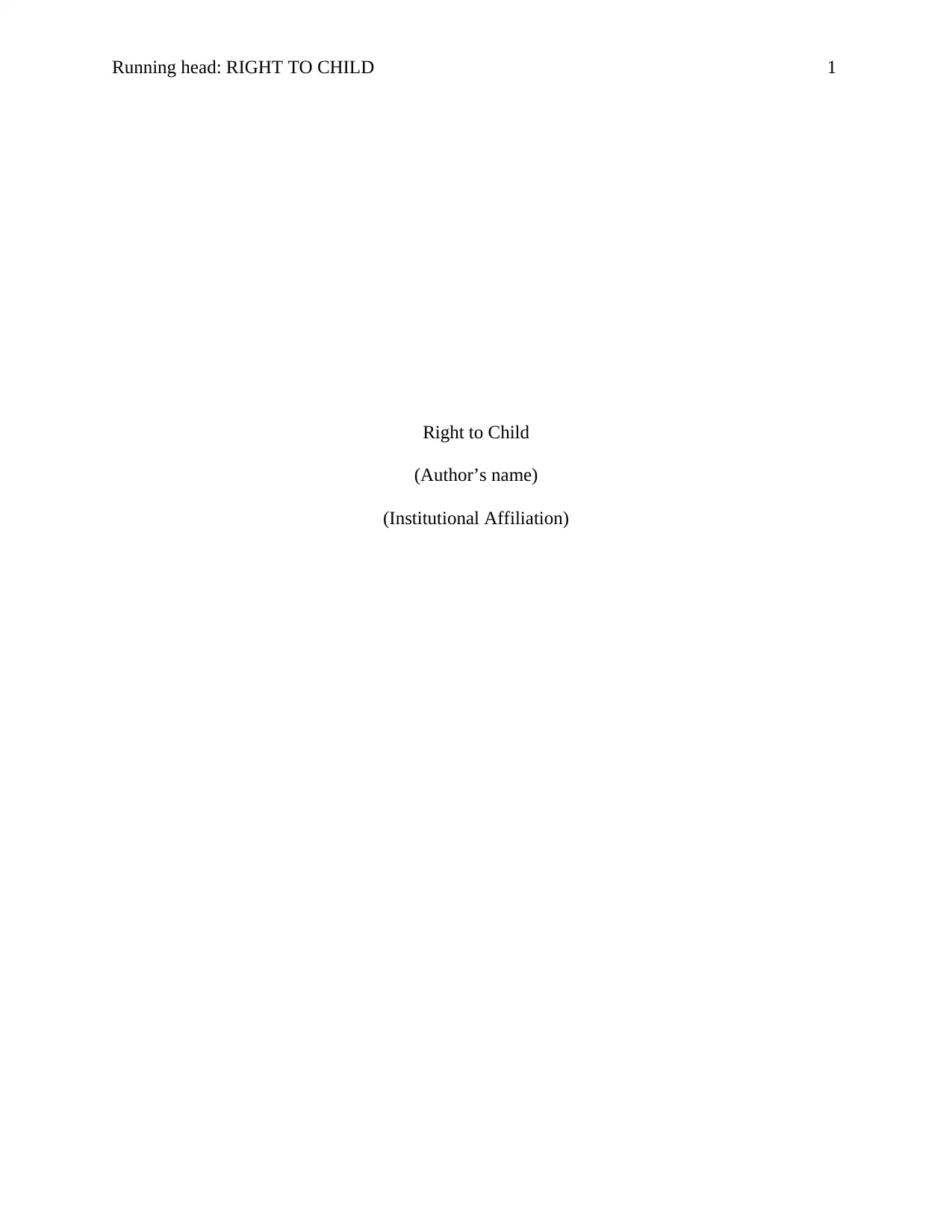
Running head: RIGHT TO CHILD 1
Right to Child
(Author’s name)
(Institutional Affiliation)
Right to Child
(Author’s name)
(Institutional Affiliation)
Paraphrase This Document
Need a fresh take? Get an instant paraphrase of this document with our AI Paraphraser
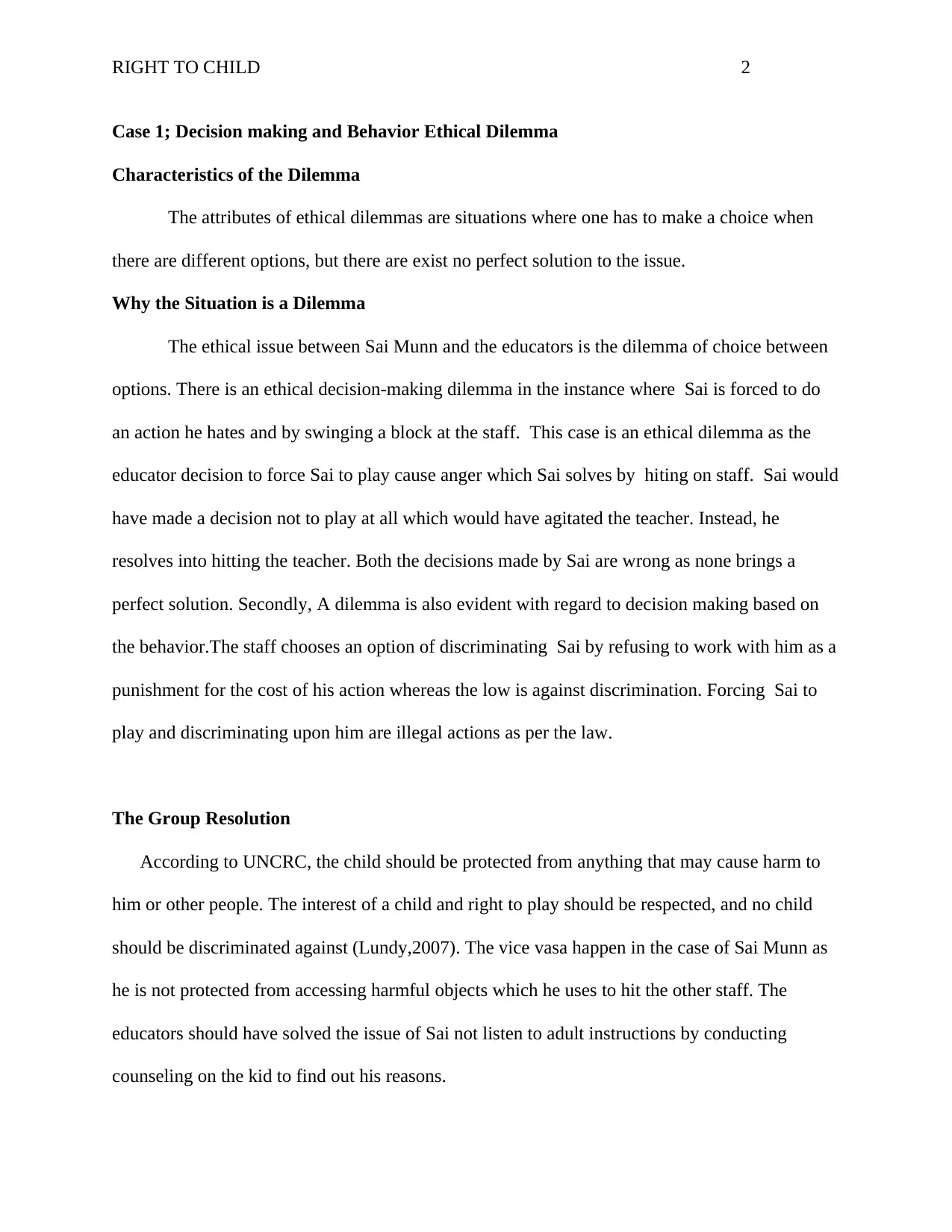
RIGHT TO CHILD 2
Case 1; Decision making and Behavior Ethical Dilemma
Characteristics of the Dilemma
The attributes of ethical dilemmas are situations where one has to make a choice when
there are different options, but there are exist no perfect solution to the issue.
Why the Situation is a Dilemma
The ethical issue between Sai Munn and the educators is the dilemma of choice between
options. There is an ethical decision-making dilemma in the instance where Sai is forced to do
an action he hates and by swinging a block at the staff. This case is an ethical dilemma as the
educator decision to force Sai to play cause anger which Sai solves by hiting on staff. Sai would
have made a decision not to play at all which would have agitated the teacher. Instead, he
resolves into hitting the teacher. Both the decisions made by Sai are wrong as none brings a
perfect solution. Secondly, A dilemma is also evident with regard to decision making based on
the behavior.The staff chooses an option of discriminating Sai by refusing to work with him as a
punishment for the cost of his action whereas the low is against discrimination. Forcing Sai to
play and discriminating upon him are illegal actions as per the law.
The Group Resolution
According to UNCRC, the child should be protected from anything that may cause harm to
him or other people. The interest of a child and right to play should be respected, and no child
should be discriminated against (Lundy,2007). The vice vasa happen in the case of Sai Munn as
he is not protected from accessing harmful objects which he uses to hit the other staff. The
educators should have solved the issue of Sai not listen to adult instructions by conducting
counseling on the kid to find out his reasons.
Case 1; Decision making and Behavior Ethical Dilemma
Characteristics of the Dilemma
The attributes of ethical dilemmas are situations where one has to make a choice when
there are different options, but there are exist no perfect solution to the issue.
Why the Situation is a Dilemma
The ethical issue between Sai Munn and the educators is the dilemma of choice between
options. There is an ethical decision-making dilemma in the instance where Sai is forced to do
an action he hates and by swinging a block at the staff. This case is an ethical dilemma as the
educator decision to force Sai to play cause anger which Sai solves by hiting on staff. Sai would
have made a decision not to play at all which would have agitated the teacher. Instead, he
resolves into hitting the teacher. Both the decisions made by Sai are wrong as none brings a
perfect solution. Secondly, A dilemma is also evident with regard to decision making based on
the behavior.The staff chooses an option of discriminating Sai by refusing to work with him as a
punishment for the cost of his action whereas the low is against discrimination. Forcing Sai to
play and discriminating upon him are illegal actions as per the law.
The Group Resolution
According to UNCRC, the child should be protected from anything that may cause harm to
him or other people. The interest of a child and right to play should be respected, and no child
should be discriminated against (Lundy,2007). The vice vasa happen in the case of Sai Munn as
he is not protected from accessing harmful objects which he uses to hit the other staff. The
educators should have solved the issue of Sai not listen to adult instructions by conducting
counseling on the kid to find out his reasons.
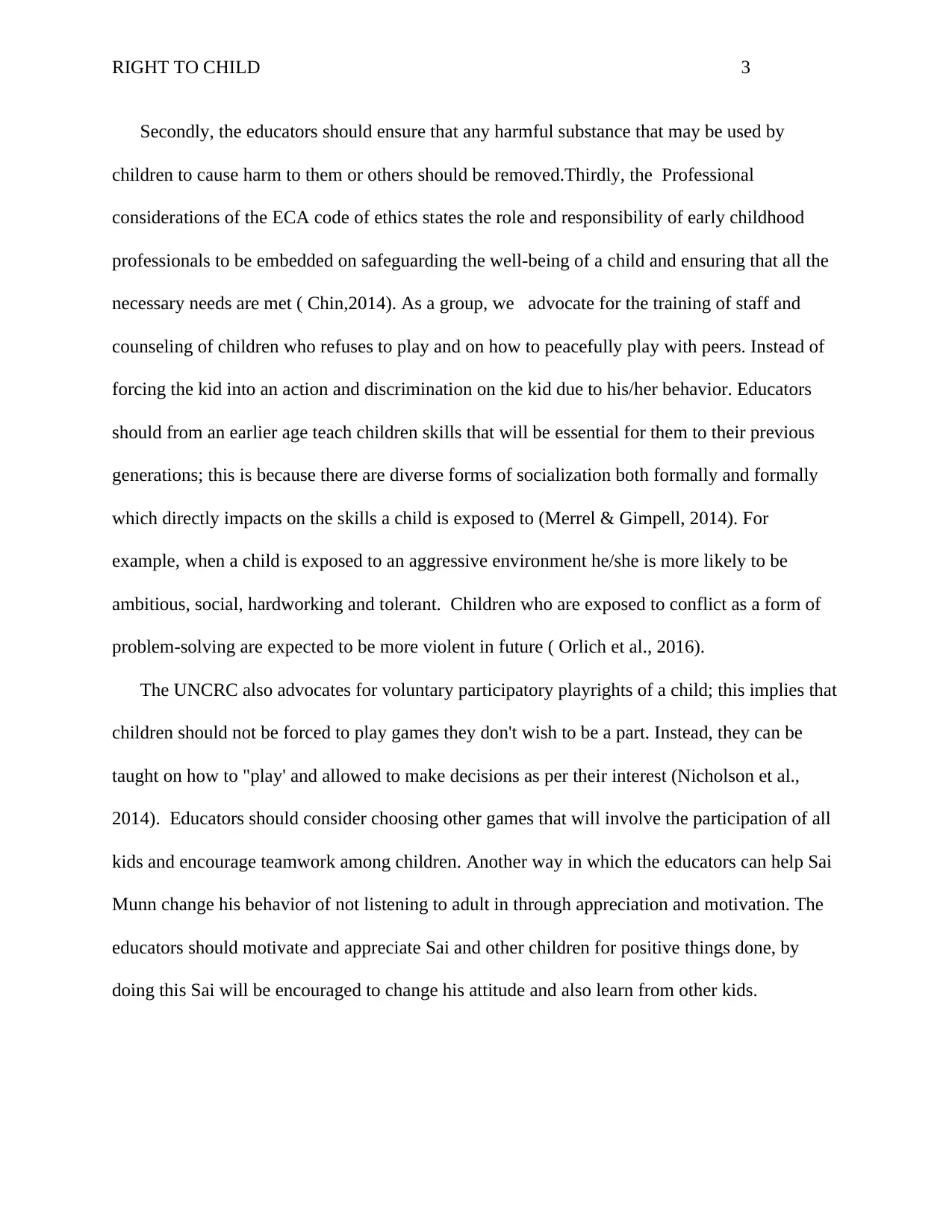
RIGHT TO CHILD 3
Secondly, the educators should ensure that any harmful substance that may be used by
children to cause harm to them or others should be removed.Thirdly, the Professional
considerations of the ECA code of ethics states the role and responsibility of early childhood
professionals to be embedded on safeguarding the well-being of a child and ensuring that all the
necessary needs are met ( Chin,2014). As a group, we advocate for the training of staff and
counseling of children who refuses to play and on how to peacefully play with peers. Instead of
forcing the kid into an action and discrimination on the kid due to his/her behavior. Educators
should from an earlier age teach children skills that will be essential for them to their previous
generations; this is because there are diverse forms of socialization both formally and formally
which directly impacts on the skills a child is exposed to (Merrel & Gimpell, 2014). For
example, when a child is exposed to an aggressive environment he/she is more likely to be
ambitious, social, hardworking and tolerant. Children who are exposed to conflict as a form of
problem-solving are expected to be more violent in future ( Orlich et al., 2016).
The UNCRC also advocates for voluntary participatory playrights of a child; this implies that
children should not be forced to play games they don't wish to be a part. Instead, they can be
taught on how to "play' and allowed to make decisions as per their interest (Nicholson et al.,
2014). Educators should consider choosing other games that will involve the participation of all
kids and encourage teamwork among children. Another way in which the educators can help Sai
Munn change his behavior of not listening to adult in through appreciation and motivation. The
educators should motivate and appreciate Sai and other children for positive things done, by
doing this Sai will be encouraged to change his attitude and also learn from other kids.
Secondly, the educators should ensure that any harmful substance that may be used by
children to cause harm to them or others should be removed.Thirdly, the Professional
considerations of the ECA code of ethics states the role and responsibility of early childhood
professionals to be embedded on safeguarding the well-being of a child and ensuring that all the
necessary needs are met ( Chin,2014). As a group, we advocate for the training of staff and
counseling of children who refuses to play and on how to peacefully play with peers. Instead of
forcing the kid into an action and discrimination on the kid due to his/her behavior. Educators
should from an earlier age teach children skills that will be essential for them to their previous
generations; this is because there are diverse forms of socialization both formally and formally
which directly impacts on the skills a child is exposed to (Merrel & Gimpell, 2014). For
example, when a child is exposed to an aggressive environment he/she is more likely to be
ambitious, social, hardworking and tolerant. Children who are exposed to conflict as a form of
problem-solving are expected to be more violent in future ( Orlich et al., 2016).
The UNCRC also advocates for voluntary participatory playrights of a child; this implies that
children should not be forced to play games they don't wish to be a part. Instead, they can be
taught on how to "play' and allowed to make decisions as per their interest (Nicholson et al.,
2014). Educators should consider choosing other games that will involve the participation of all
kids and encourage teamwork among children. Another way in which the educators can help Sai
Munn change his behavior of not listening to adult in through appreciation and motivation. The
educators should motivate and appreciate Sai and other children for positive things done, by
doing this Sai will be encouraged to change his attitude and also learn from other kids.
⊘ This is a preview!⊘
Do you want full access?
Subscribe today to unlock all pages.

Trusted by 1+ million students worldwide
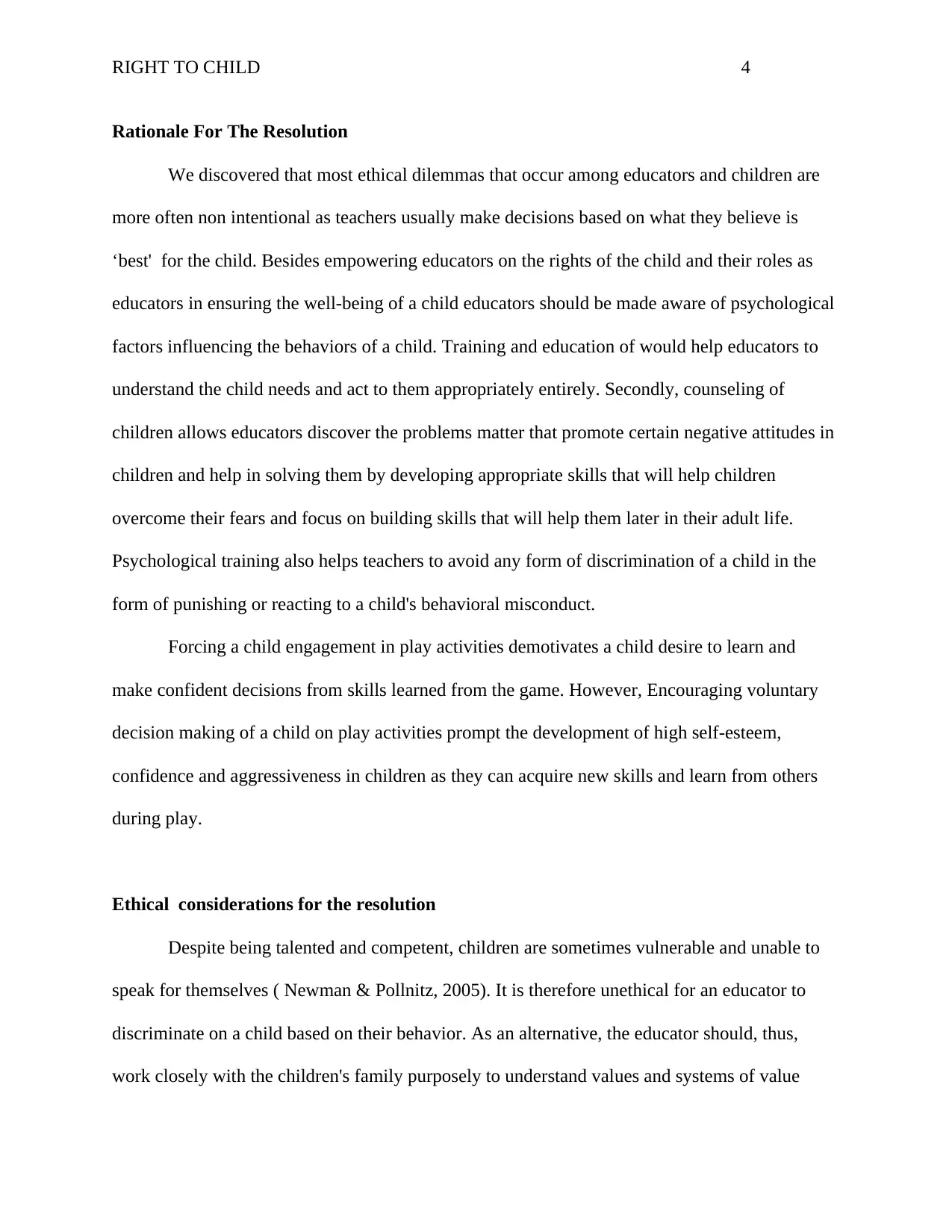
RIGHT TO CHILD 4
Rationale For The Resolution
We discovered that most ethical dilemmas that occur among educators and children are
more often non intentional as teachers usually make decisions based on what they believe is
‘best' for the child. Besides empowering educators on the rights of the child and their roles as
educators in ensuring the well-being of a child educators should be made aware of psychological
factors influencing the behaviors of a child. Training and education of would help educators to
understand the child needs and act to them appropriately entirely. Secondly, counseling of
children allows educators discover the problems matter that promote certain negative attitudes in
children and help in solving them by developing appropriate skills that will help children
overcome their fears and focus on building skills that will help them later in their adult life.
Psychological training also helps teachers to avoid any form of discrimination of a child in the
form of punishing or reacting to a child's behavioral misconduct.
Forcing a child engagement in play activities demotivates a child desire to learn and
make confident decisions from skills learned from the game. However, Encouraging voluntary
decision making of a child on play activities prompt the development of high self-esteem,
confidence and aggressiveness in children as they can acquire new skills and learn from others
during play.
Ethical considerations for the resolution
Despite being talented and competent, children are sometimes vulnerable and unable to
speak for themselves ( Newman & Pollnitz, 2005). It is therefore unethical for an educator to
discriminate on a child based on their behavior. As an alternative, the educator should, thus,
work closely with the children's family purposely to understand values and systems of value
Rationale For The Resolution
We discovered that most ethical dilemmas that occur among educators and children are
more often non intentional as teachers usually make decisions based on what they believe is
‘best' for the child. Besides empowering educators on the rights of the child and their roles as
educators in ensuring the well-being of a child educators should be made aware of psychological
factors influencing the behaviors of a child. Training and education of would help educators to
understand the child needs and act to them appropriately entirely. Secondly, counseling of
children allows educators discover the problems matter that promote certain negative attitudes in
children and help in solving them by developing appropriate skills that will help children
overcome their fears and focus on building skills that will help them later in their adult life.
Psychological training also helps teachers to avoid any form of discrimination of a child in the
form of punishing or reacting to a child's behavioral misconduct.
Forcing a child engagement in play activities demotivates a child desire to learn and
make confident decisions from skills learned from the game. However, Encouraging voluntary
decision making of a child on play activities prompt the development of high self-esteem,
confidence and aggressiveness in children as they can acquire new skills and learn from others
during play.
Ethical considerations for the resolution
Despite being talented and competent, children are sometimes vulnerable and unable to
speak for themselves ( Newman & Pollnitz, 2005). It is therefore unethical for an educator to
discriminate on a child based on their behavior. As an alternative, the educator should, thus,
work closely with the children's family purposely to understand values and systems of value
Paraphrase This Document
Need a fresh take? Get an instant paraphrase of this document with our AI Paraphraser
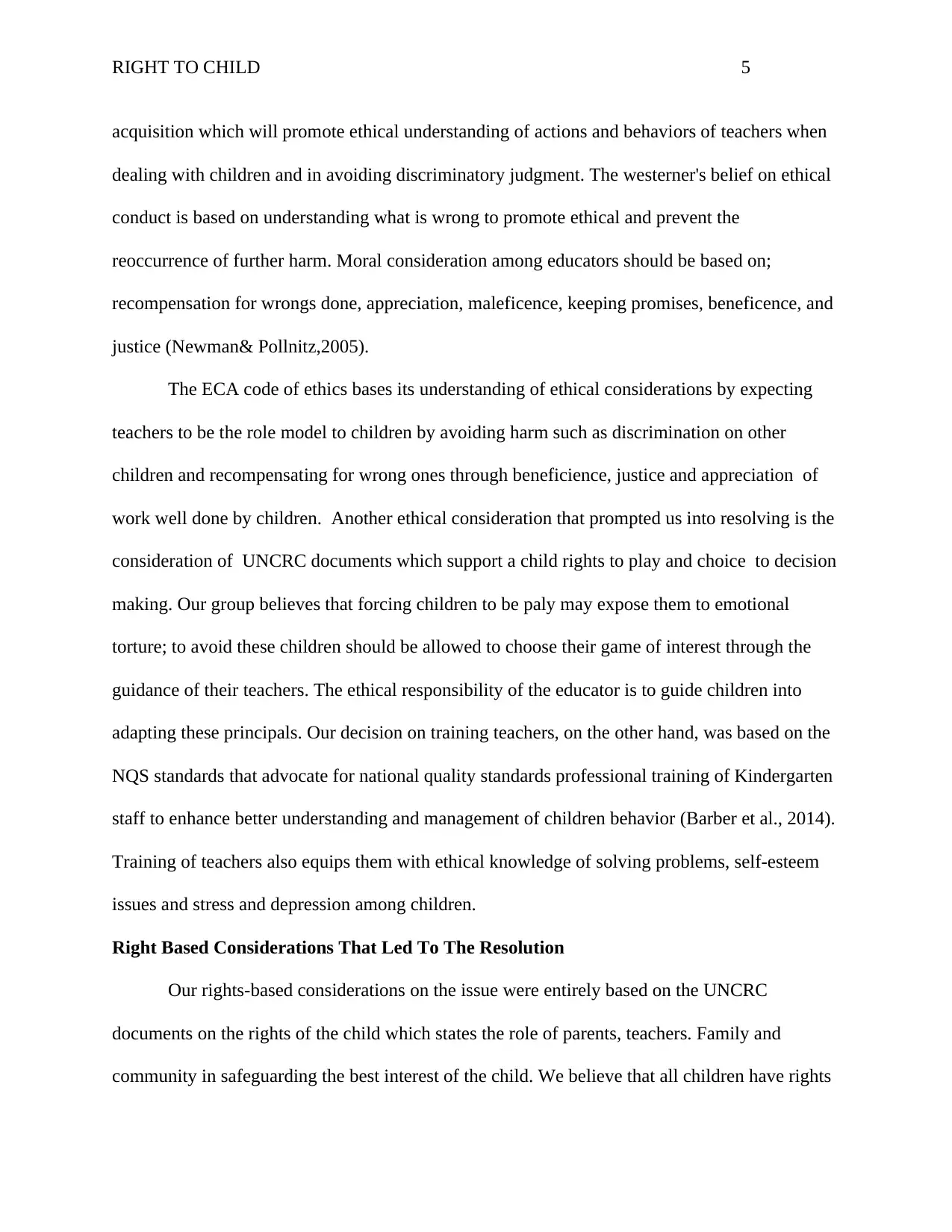
RIGHT TO CHILD 5
acquisition which will promote ethical understanding of actions and behaviors of teachers when
dealing with children and in avoiding discriminatory judgment. The westerner's belief on ethical
conduct is based on understanding what is wrong to promote ethical and prevent the
reoccurrence of further harm. Moral consideration among educators should be based on;
recompensation for wrongs done, appreciation, maleficence, keeping promises, beneficence, and
justice (Newman& Pollnitz,2005).
The ECA code of ethics bases its understanding of ethical considerations by expecting
teachers to be the role model to children by avoiding harm such as discrimination on other
children and recompensating for wrong ones through beneficience, justice and appreciation of
work well done by children. Another ethical consideration that prompted us into resolving is the
consideration of UNCRC documents which support a child rights to play and choice to decision
making. Our group believes that forcing children to be paly may expose them to emotional
torture; to avoid these children should be allowed to choose their game of interest through the
guidance of their teachers. The ethical responsibility of the educator is to guide children into
adapting these principals. Our decision on training teachers, on the other hand, was based on the
NQS standards that advocate for national quality standards professional training of Kindergarten
staff to enhance better understanding and management of children behavior (Barber et al., 2014).
Training of teachers also equips them with ethical knowledge of solving problems, self-esteem
issues and stress and depression among children.
Right Based Considerations That Led To The Resolution
Our rights-based considerations on the issue were entirely based on the UNCRC
documents on the rights of the child which states the role of parents, teachers. Family and
community in safeguarding the best interest of the child. We believe that all children have rights
acquisition which will promote ethical understanding of actions and behaviors of teachers when
dealing with children and in avoiding discriminatory judgment. The westerner's belief on ethical
conduct is based on understanding what is wrong to promote ethical and prevent the
reoccurrence of further harm. Moral consideration among educators should be based on;
recompensation for wrongs done, appreciation, maleficence, keeping promises, beneficence, and
justice (Newman& Pollnitz,2005).
The ECA code of ethics bases its understanding of ethical considerations by expecting
teachers to be the role model to children by avoiding harm such as discrimination on other
children and recompensating for wrong ones through beneficience, justice and appreciation of
work well done by children. Another ethical consideration that prompted us into resolving is the
consideration of UNCRC documents which support a child rights to play and choice to decision
making. Our group believes that forcing children to be paly may expose them to emotional
torture; to avoid these children should be allowed to choose their game of interest through the
guidance of their teachers. The ethical responsibility of the educator is to guide children into
adapting these principals. Our decision on training teachers, on the other hand, was based on the
NQS standards that advocate for national quality standards professional training of Kindergarten
staff to enhance better understanding and management of children behavior (Barber et al., 2014).
Training of teachers also equips them with ethical knowledge of solving problems, self-esteem
issues and stress and depression among children.
Right Based Considerations That Led To The Resolution
Our rights-based considerations on the issue were entirely based on the UNCRC
documents on the rights of the child which states the role of parents, teachers. Family and
community in safeguarding the best interest of the child. We believe that all children have rights
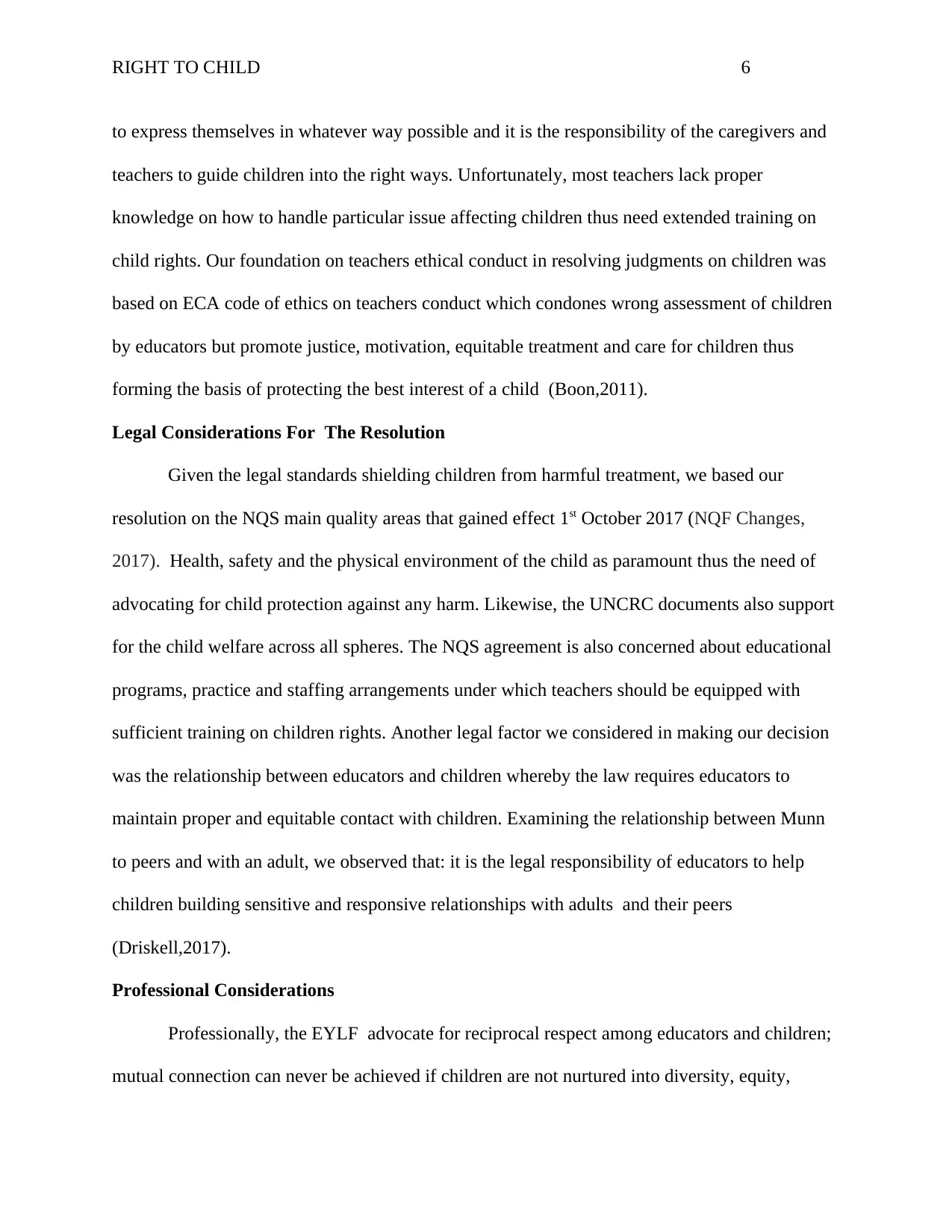
RIGHT TO CHILD 6
to express themselves in whatever way possible and it is the responsibility of the caregivers and
teachers to guide children into the right ways. Unfortunately, most teachers lack proper
knowledge on how to handle particular issue affecting children thus need extended training on
child rights. Our foundation on teachers ethical conduct in resolving judgments on children was
based on ECA code of ethics on teachers conduct which condones wrong assessment of children
by educators but promote justice, motivation, equitable treatment and care for children thus
forming the basis of protecting the best interest of a child (Boon,2011).
Legal Considerations For The Resolution
Given the legal standards shielding children from harmful treatment, we based our
resolution on the NQS main quality areas that gained effect 1st October 2017 (NQF Changes,
2017). Health, safety and the physical environment of the child as paramount thus the need of
advocating for child protection against any harm. Likewise, the UNCRC documents also support
for the child welfare across all spheres. The NQS agreement is also concerned about educational
programs, practice and staffing arrangements under which teachers should be equipped with
sufficient training on children rights. Another legal factor we considered in making our decision
was the relationship between educators and children whereby the law requires educators to
maintain proper and equitable contact with children. Examining the relationship between Munn
to peers and with an adult, we observed that: it is the legal responsibility of educators to help
children building sensitive and responsive relationships with adults and their peers
(Driskell,2017).
Professional Considerations
Professionally, the EYLF advocate for reciprocal respect among educators and children;
mutual connection can never be achieved if children are not nurtured into diversity, equity,
to express themselves in whatever way possible and it is the responsibility of the caregivers and
teachers to guide children into the right ways. Unfortunately, most teachers lack proper
knowledge on how to handle particular issue affecting children thus need extended training on
child rights. Our foundation on teachers ethical conduct in resolving judgments on children was
based on ECA code of ethics on teachers conduct which condones wrong assessment of children
by educators but promote justice, motivation, equitable treatment and care for children thus
forming the basis of protecting the best interest of a child (Boon,2011).
Legal Considerations For The Resolution
Given the legal standards shielding children from harmful treatment, we based our
resolution on the NQS main quality areas that gained effect 1st October 2017 (NQF Changes,
2017). Health, safety and the physical environment of the child as paramount thus the need of
advocating for child protection against any harm. Likewise, the UNCRC documents also support
for the child welfare across all spheres. The NQS agreement is also concerned about educational
programs, practice and staffing arrangements under which teachers should be equipped with
sufficient training on children rights. Another legal factor we considered in making our decision
was the relationship between educators and children whereby the law requires educators to
maintain proper and equitable contact with children. Examining the relationship between Munn
to peers and with an adult, we observed that: it is the legal responsibility of educators to help
children building sensitive and responsive relationships with adults and their peers
(Driskell,2017).
Professional Considerations
Professionally, the EYLF advocate for reciprocal respect among educators and children;
mutual connection can never be achieved if children are not nurtured into diversity, equity,
⊘ This is a preview!⊘
Do you want full access?
Subscribe today to unlock all pages.

Trusted by 1+ million students worldwide
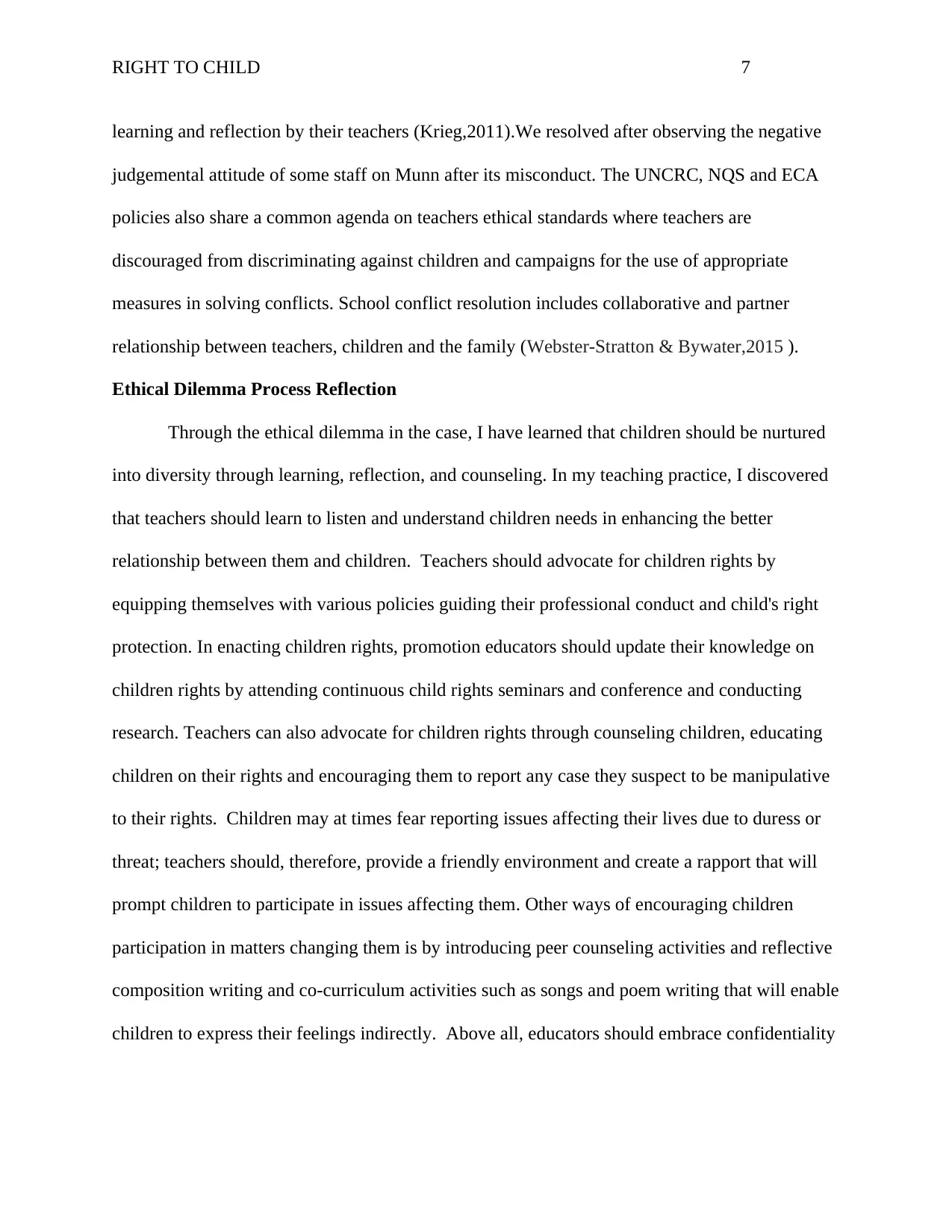
RIGHT TO CHILD 7
learning and reflection by their teachers (Krieg,2011).We resolved after observing the negative
judgemental attitude of some staff on Munn after its misconduct. The UNCRC, NQS and ECA
policies also share a common agenda on teachers ethical standards where teachers are
discouraged from discriminating against children and campaigns for the use of appropriate
measures in solving conflicts. School conflict resolution includes collaborative and partner
relationship between teachers, children and the family (Webster-Stratton & Bywater,2015 ).
Ethical Dilemma Process Reflection
Through the ethical dilemma in the case, I have learned that children should be nurtured
into diversity through learning, reflection, and counseling. In my teaching practice, I discovered
that teachers should learn to listen and understand children needs in enhancing the better
relationship between them and children. Teachers should advocate for children rights by
equipping themselves with various policies guiding their professional conduct and child's right
protection. In enacting children rights, promotion educators should update their knowledge on
children rights by attending continuous child rights seminars and conference and conducting
research. Teachers can also advocate for children rights through counseling children, educating
children on their rights and encouraging them to report any case they suspect to be manipulative
to their rights. Children may at times fear reporting issues affecting their lives due to duress or
threat; teachers should, therefore, provide a friendly environment and create a rapport that will
prompt children to participate in issues affecting them. Other ways of encouraging children
participation in matters changing them is by introducing peer counseling activities and reflective
composition writing and co-curriculum activities such as songs and poem writing that will enable
children to express their feelings indirectly. Above all, educators should embrace confidentiality
learning and reflection by their teachers (Krieg,2011).We resolved after observing the negative
judgemental attitude of some staff on Munn after its misconduct. The UNCRC, NQS and ECA
policies also share a common agenda on teachers ethical standards where teachers are
discouraged from discriminating against children and campaigns for the use of appropriate
measures in solving conflicts. School conflict resolution includes collaborative and partner
relationship between teachers, children and the family (Webster-Stratton & Bywater,2015 ).
Ethical Dilemma Process Reflection
Through the ethical dilemma in the case, I have learned that children should be nurtured
into diversity through learning, reflection, and counseling. In my teaching practice, I discovered
that teachers should learn to listen and understand children needs in enhancing the better
relationship between them and children. Teachers should advocate for children rights by
equipping themselves with various policies guiding their professional conduct and child's right
protection. In enacting children rights, promotion educators should update their knowledge on
children rights by attending continuous child rights seminars and conference and conducting
research. Teachers can also advocate for children rights through counseling children, educating
children on their rights and encouraging them to report any case they suspect to be manipulative
to their rights. Children may at times fear reporting issues affecting their lives due to duress or
threat; teachers should, therefore, provide a friendly environment and create a rapport that will
prompt children to participate in issues affecting them. Other ways of encouraging children
participation in matters changing them is by introducing peer counseling activities and reflective
composition writing and co-curriculum activities such as songs and poem writing that will enable
children to express their feelings indirectly. Above all, educators should embrace confidentiality
Paraphrase This Document
Need a fresh take? Get an instant paraphrase of this document with our AI Paraphraser

RIGHT TO CHILD 8
to promote informed participation of kids by opening on issues affecting them (Mayne et
al.,2016). Breach of privacy may discourage children from opening up on issues affecting them.
to promote informed participation of kids by opening on issues affecting them (Mayne et
al.,2016). Breach of privacy may discourage children from opening up on issues affecting them.
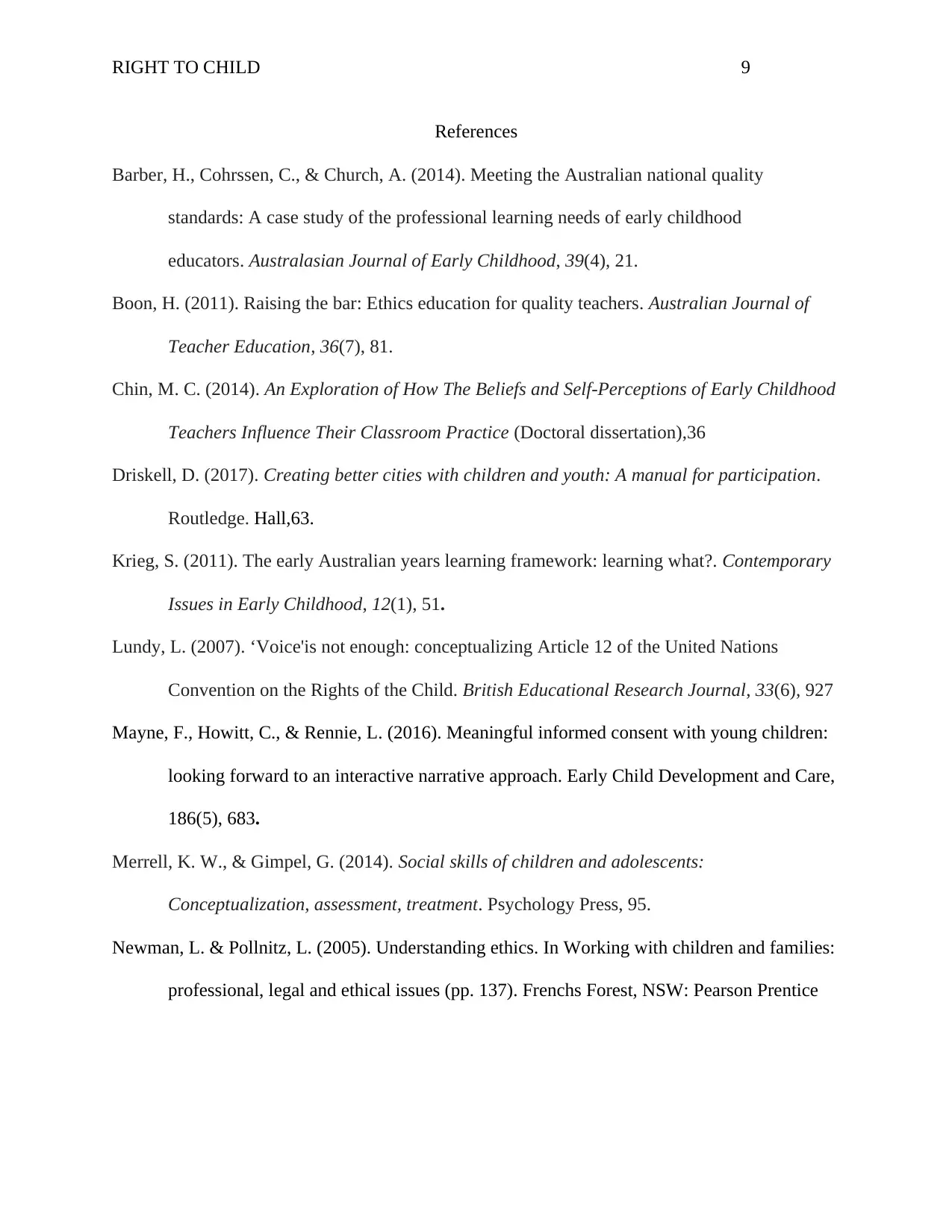
RIGHT TO CHILD 9
References
Barber, H., Cohrssen, C., & Church, A. (2014). Meeting the Australian national quality
standards: A case study of the professional learning needs of early childhood
educators. Australasian Journal of Early Childhood, 39(4), 21.
Boon, H. (2011). Raising the bar: Ethics education for quality teachers. Australian Journal of
Teacher Education, 36(7), 81.
Chin, M. C. (2014). An Exploration of How The Beliefs and Self-Perceptions of Early Childhood
Teachers Influence Their Classroom Practice (Doctoral dissertation),36
Driskell, D. (2017). Creating better cities with children and youth: A manual for participation.
Routledge. Hall,63.
Krieg, S. (2011). The early Australian years learning framework: learning what?. Contemporary
Issues in Early Childhood, 12(1), 51.
Lundy, L. (2007). ‘Voice'is not enough: conceptualizing Article 12 of the United Nations
Convention on the Rights of the Child. British Educational Research Journal, 33(6), 927
Mayne, F., Howitt, C., & Rennie, L. (2016). Meaningful informed consent with young children:
looking forward to an interactive narrative approach. Early Child Development and Care,
186(5), 683.
Merrell, K. W., & Gimpel, G. (2014). Social skills of children and adolescents:
Conceptualization, assessment, treatment. Psychology Press, 95.
Newman, L. & Pollnitz, L. (2005). Understanding ethics. In Working with children and families:
professional, legal and ethical issues (pp. 137). Frenchs Forest, NSW: Pearson Prentice
References
Barber, H., Cohrssen, C., & Church, A. (2014). Meeting the Australian national quality
standards: A case study of the professional learning needs of early childhood
educators. Australasian Journal of Early Childhood, 39(4), 21.
Boon, H. (2011). Raising the bar: Ethics education for quality teachers. Australian Journal of
Teacher Education, 36(7), 81.
Chin, M. C. (2014). An Exploration of How The Beliefs and Self-Perceptions of Early Childhood
Teachers Influence Their Classroom Practice (Doctoral dissertation),36
Driskell, D. (2017). Creating better cities with children and youth: A manual for participation.
Routledge. Hall,63.
Krieg, S. (2011). The early Australian years learning framework: learning what?. Contemporary
Issues in Early Childhood, 12(1), 51.
Lundy, L. (2007). ‘Voice'is not enough: conceptualizing Article 12 of the United Nations
Convention on the Rights of the Child. British Educational Research Journal, 33(6), 927
Mayne, F., Howitt, C., & Rennie, L. (2016). Meaningful informed consent with young children:
looking forward to an interactive narrative approach. Early Child Development and Care,
186(5), 683.
Merrell, K. W., & Gimpel, G. (2014). Social skills of children and adolescents:
Conceptualization, assessment, treatment. Psychology Press, 95.
Newman, L. & Pollnitz, L. (2005). Understanding ethics. In Working with children and families:
professional, legal and ethical issues (pp. 137). Frenchs Forest, NSW: Pearson Prentice
⊘ This is a preview!⊘
Do you want full access?
Subscribe today to unlock all pages.

Trusted by 1+ million students worldwide
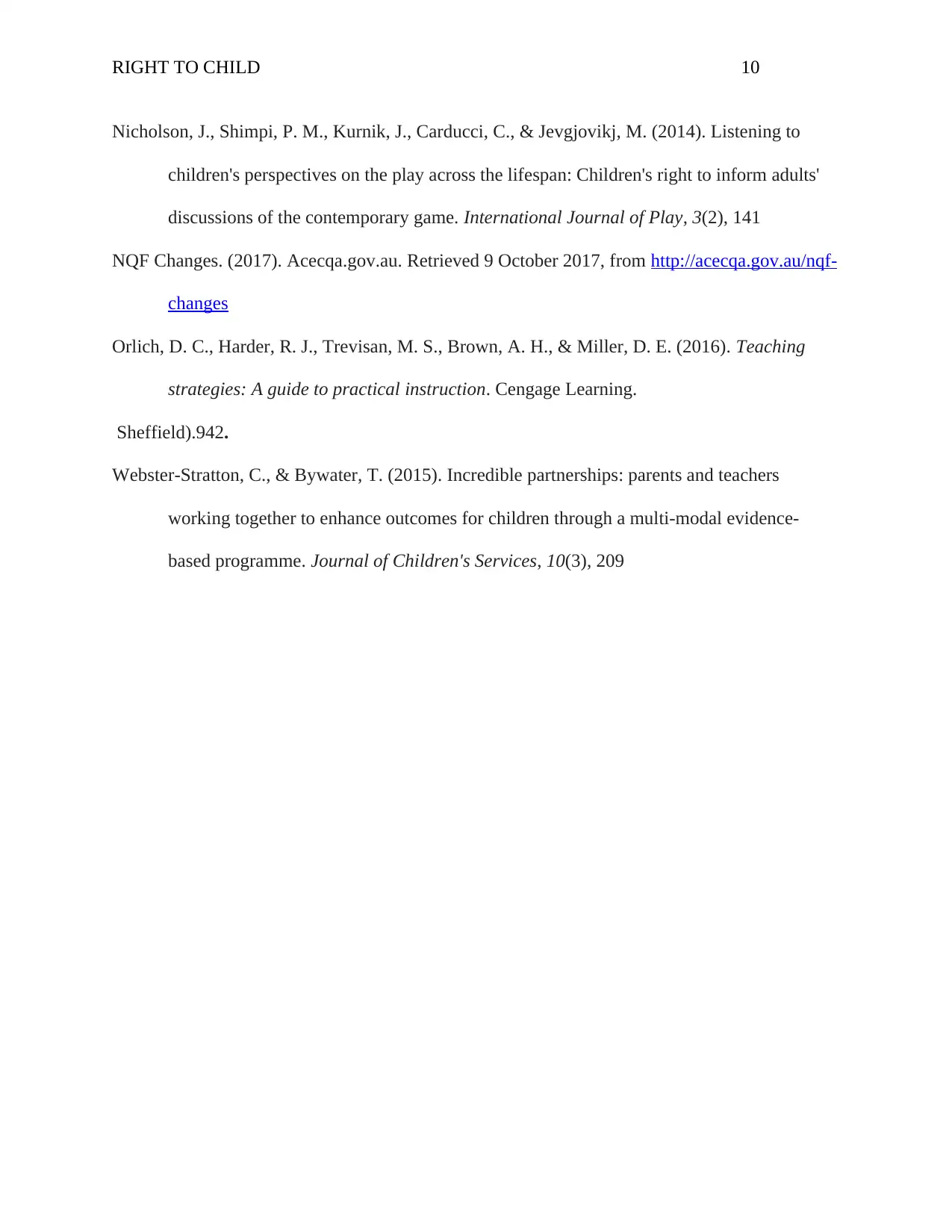
RIGHT TO CHILD 10
Nicholson, J., Shimpi, P. M., Kurnik, J., Carducci, C., & Jevgjovikj, M. (2014). Listening to
children's perspectives on the play across the lifespan: Children's right to inform adults'
discussions of the contemporary game. International Journal of Play, 3(2), 141
NQF Changes. (2017). Acecqa.gov.au. Retrieved 9 October 2017, from http://acecqa.gov.au/nqf-
changes
Orlich, D. C., Harder, R. J., Trevisan, M. S., Brown, A. H., & Miller, D. E. (2016). Teaching
strategies: A guide to practical instruction. Cengage Learning.
Sheffield).942.
Webster-Stratton, C., & Bywater, T. (2015). Incredible partnerships: parents and teachers
working together to enhance outcomes for children through a multi-modal evidence-
based programme. Journal of Children's Services, 10(3), 209
Nicholson, J., Shimpi, P. M., Kurnik, J., Carducci, C., & Jevgjovikj, M. (2014). Listening to
children's perspectives on the play across the lifespan: Children's right to inform adults'
discussions of the contemporary game. International Journal of Play, 3(2), 141
NQF Changes. (2017). Acecqa.gov.au. Retrieved 9 October 2017, from http://acecqa.gov.au/nqf-
changes
Orlich, D. C., Harder, R. J., Trevisan, M. S., Brown, A. H., & Miller, D. E. (2016). Teaching
strategies: A guide to practical instruction. Cengage Learning.
Sheffield).942.
Webster-Stratton, C., & Bywater, T. (2015). Incredible partnerships: parents and teachers
working together to enhance outcomes for children through a multi-modal evidence-
based programme. Journal of Children's Services, 10(3), 209
1 out of 10
Your All-in-One AI-Powered Toolkit for Academic Success.
+13062052269
info@desklib.com
Available 24*7 on WhatsApp / Email
![[object Object]](/_next/static/media/star-bottom.7253800d.svg)
Unlock your academic potential
Copyright © 2020–2025 A2Z Services. All Rights Reserved. Developed and managed by ZUCOL.


